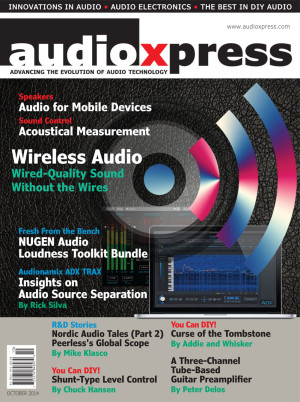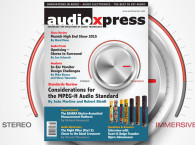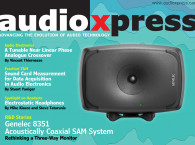
Our October cover story highlights the start of a new series on Wireless Audio, which is certainly one of the more exciting technologies in the industry. In the introduction to this subject, we look back at underlying technologies—from digital radio and digital television, wireless microphones, and in-ear monitoring to Bluetooth and Wi-Fi—that made wireless audio transmission available to all of us. With Bluetooth 4.1+HS, the evolution in the Institute of Electrical and Electronics Engineers (IEEE) 802.11 Wi-Fi standards, and new efficient streaming and networking protocols, we are close to the ideal solution. Many companies are heavily investing in this area, attempting to make “wired-quality sound without the wires” possible. But as we explore the available technologies, we realize how much more this entails than simply “replacing cables.”
In another timely topic, our usual “Speakers” column from Mike Klasco and Steve Tatarunis turns to the fascinating subject of “Audio for Mobile Devices.” Microspeakers for mobile audio use represent the smallest speakers. Yet, they also present the greatest challenge to designers. This article discusses the trade-offs between speaker size and sound quality in the continuous search to increase efficiency, power handling, and extended bass response at the lowest possible price.
Audio engineer and historian Tom Fine gave an excellent presentation at the 135th International AES Convention in New York last year. Titled “The 35-mm Album Master Fad,” Fine’s two-hour history details the use of 35-mm magnetic film for LP mastering between 1959 and 1970 and provided a thorough overview of recorded sound history on 35-mm magnetic film. Gary Galo explores the impact 35-mm recordings had on today’s audio in the first part of his two-part article based on Fine’s presentation.
This edition also features the second part of our article series dedicated to the speaker brands from the northern regions of Europe. We revisit the fascinating histories from some of the region’s speaker manufacturers and, in “Nordic Audio Tales: Part 2,” Mike Klasco focuses on Peerless, which is now Tymphany.
From a more practical perspective, we review NUGEN Audio’s Loudness Toolkit Bundle. Miguel Marques examines NUGEN Audio’s new generation of metering tools for accurately measuring loudness, which is one of the greatest and probably the most game-changing advancements professional audio has seen in the last few years.
Next, for those interested in advanced audio processing techniques, Rick Silva from Audionamix explains how the company approached audio source separation using its new software, ADX TRAX. The article provides some insight on how Audionamix’ software delivers pristine voice isolations for everything from blockbuster movies and 3-D animated shorts to virtual duets by legendary artists, and exciting new remixes by top DJs and music producers.
This month, our Sound Control column looks at “Acoustical Measurement.” As Richard Honeycutt explains, “A long time has passed since Lord Rayleigh (John William Strutt) measured air velocity by means of the Rayleigh disc, Sir Charles Wheatstone used sympathetic vibrations of tuning forks to determine frequency, and Baron Hermann Ludwig Ferdinand von Helmholtz devised his resonator for the same purpose. Ever since Edward C. Wente of Bell Laboratories invented the capacitor microphone, field measurements of acoustical parameters have mainly utilized electrical and electronic instruments, although the purely physical methods continue to find use in primary calibration laboratories.”
Our monthly interview with industry personalities, pioneers, and visionaries, features Bob Katz, founder of Revolution Acoustics, the company behind the SSP6 Multiducer (multifunctional transducer), which transforms nearly any panel structure into an audio speaker. In his interview with Shannon Becker, Katz explains how his curiosity led to those audio technology innovations.
For our DIY audio readers, we bring you a shunt-type level control project by Chuck Hansen. In this article, Hansen explains how to build a passive shunt attenuator for optimum fine control over the signal voltage from any signal generator.
Addie and Whisker share another great project in “Curse of the Tombstone,” explaining how they transformed a 1936 Philco radio, a Leslie Type 25 tube amplifier, and a 12” field coil speaker into a one-of-a-kind guitar amplifier.
Peter Delos details how to add tone controls to a three-channel tube-based guitar preamplifier. The circuit is a versatile building block anyone can use for his or her own preamplifier applications.
Finally, this month’s Hollow-State Electronics column discusses “Controlled-Source Theory in Hollow-State Design.” As Richard Honeycutt explains, when we think in terms of functional blocks such as amplifiers and tuners, as well as smaller blocks such as preamplifiers, phase splitters, and power amplifiers, there are certain behaviors we associate with the block. There is a class of functional blocks associated with amplifiers that help us more fully understand amplifier operation. These blocks are called “controlled sources.” To clearly discuss controlled sources, we must first examine two simpler functional blocks—the ideal voltage source and the ideal current source.
Your new issue of audioXpress is now available at www.gotomyxpress.com
To become a member, visit www.audioxpress.com/page/audioXpress-Subscription-Services.html.
You can also buy a single printed issue at www.cc-webshop.com.
Or you can write to us if you would like to receive a trial offer. Click here.







